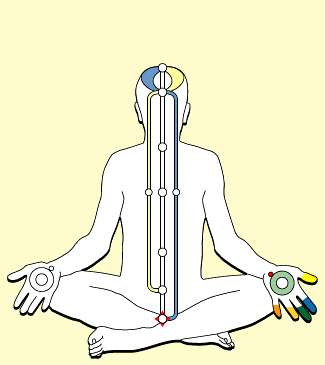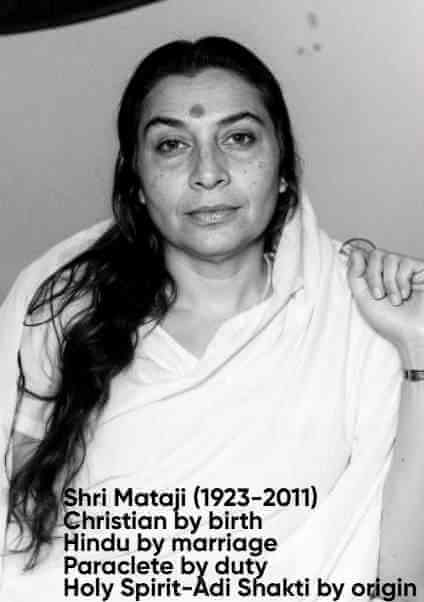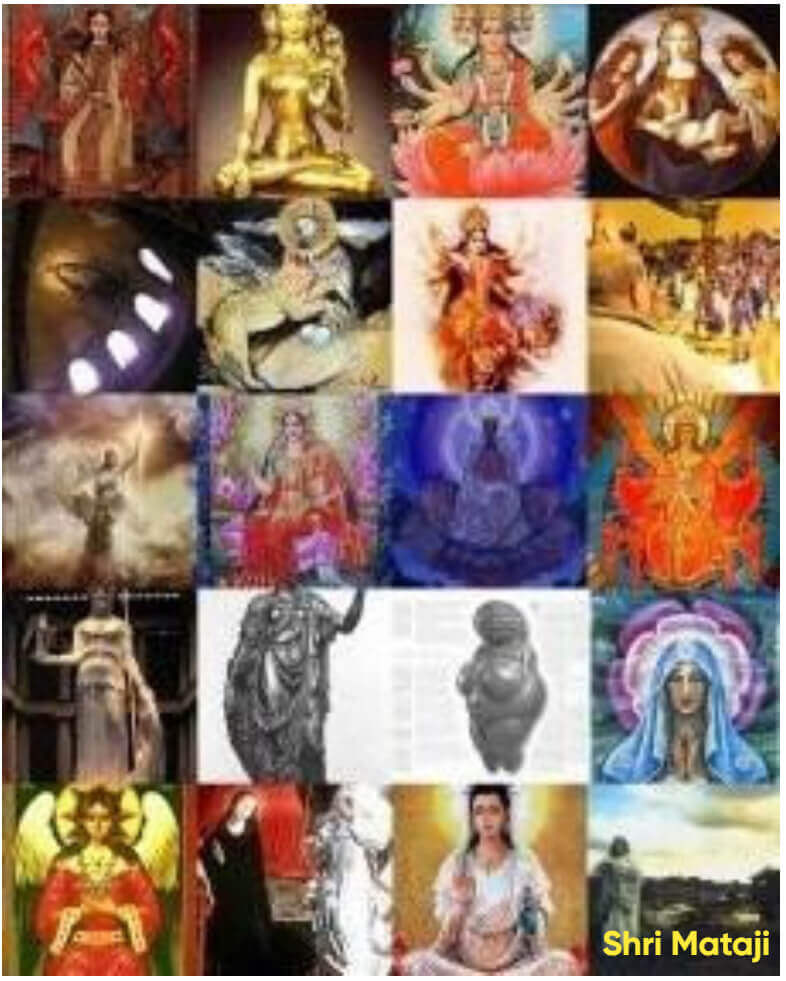Kingdom Of God Is within
This page affirms that the Kingdom of God is not a distant paradise but a living reality within. Jesus declared, “The Kingdom of God is within you,” and Shri Mataji Nirmala Devi fulfilled this promise by opening the Sahasrara chakra on May 5, 1970. This event marked the beginning of the Age of Aquarius—a time when the Divine Feminine awakens humanity en masse. The Sahasrara, the thousand-petalled lotus at the crown of the head, is the gateway to divine consciousness, the Tree of Life, and the City of God. Through Kundalini awakening, seekers enter this realm of light, truth, and eternal joy. The Kingdom is not observed outwardly—it is realized inwardly. The gates are open. The Spirit and the Bride say, “Come.”
Author: Manus AI
Abstract: This paper explores the concept of the Kingdom of God as an internal, spiritual state of being, drawing parallels between the teachings of Jesus Christ and Shri Mataji Nirmala Devi. It examines the biblical notions of being "born again" and the "Kingdom of God within you" in conjunction with the Sahaja Yoga understanding of Self-Realization and the opening of the Sahasrara Chakra. By synthesizing these two perspectives, the paper argues for a universal truth about the inner nature of spiritual awakening and its transformative potential for humanity.
Keywords: Kingdom of God, Born Again, Jesus Christ, Shri Mataji Nirmala Devi, Sahaja Yoga, Sahasrara Chakra, Kundalini, Self-Realization, Spiritual Transformation
As soon as the Sahasrara (Kingdom of God within) was opened the whole atmosphere was filled with tremendous Chaitanya. And there was tremendous Light in the sky. And the whole thing came on the Earth — as if a torrential rain or a waterfall — with such tremendous force, as if I was unaware and got stupefied.
The happening was so tremendous and so unexpected that I was stunned and totally silent at the grandeur. I saw the Primordial Kundalini rising like a big furnace, and the furnace was very silent but a burning appearance it had, as if you heat up metal, and it had many colors.
In the same way, the Kundalini showed up as a furnace, like a tunnel, as you see these plants you have here for coal burning that create electricity. And it stretched like a telescope and came out one after another, Shoo! Shoo! Shoo! Just like that. And the Deities came and sat on their seats, golden seats, and then they lifted the whole of the head like a big dome and opened it, and then this torrential rain completely drenched Me.
I started seeing all that and got lost in the Joy. It was like an artist seeing his own creation, and I felt the Joy of great fulfillment. After coming out of this beautiful experience I looked around and saw human beings so blind and I became absolutely silent, and desired that I should get the cups to fill the Nectar.
The Paraclete Shri MatajiOpening Of The Primordial Sahasrara, Sahasrara Puja, Paris, France — May 5, 1982
1. Introduction
1.1. The Enduring Quest for the Kingdom
Throughout human history, a profound and persistent yearning for a higher state of existence, a realm of peace, truth, and ultimate fulfillment, has echoed through the corridors of time. This longing, often conceptualized as the Kingdom of God, has been the driving force behind countless spiritual traditions, philosophical inquiries, and individual quests for meaning. It represents a state of being that transcends the limitations of the material world, a reality that is not bound by time or space, but is accessible to the sincere seeker. The promise of this Kingdom has inspired saints, mystics, and prophets to renounce worldly attachments and embark on arduous inner journeys, seeking to unlock the gates to this divine realm.
1.2. Two Voices, One Truth
This paper posits that the core teachings of two seemingly disparate spiritual figures, Jesus Christ and Shri Mataji Nirmala Devi, converge on a singular, profound truth: the Kingdom of God is not an external, geographical location to be conquered or a future paradise to be awaited, but an internal, spiritual reality to be experienced within the individual. While their language, cultural contexts, and historical epochs may differ, the essence of their message resonates with a remarkable harmony, pointing towards a universal pathway to spiritual awakening. This paper will explore the striking parallels between the Christian concept of being “born again” to enter the Kingdom of God and the Sahaja Yoga understanding of Self-Realization through the awakening of the Kundalini energy and the opening of the Sahasrara Chakra.
1.3. Foundational Quotes
The foundation of this exploration rests upon two pivotal statements. The first, from the Gospel of John, encapsulates the essence of Jesus’s message to Nicodemus, a learned Pharisee: “Verily, verily I say unto thee, except a man be born again, he cannot see the Kingdom of God.”[1] This declaration underscores the necessity of a profound inner transformation, a spiritual rebirth, as the prerequisite for perceiving and entering the divine realm. The second, from the teachings of Shri Mataji Nirmala Devi, offers a direct and tangible method for achieving this transformation: “But those who have got Realization will enter into the Kingdom of God. You have to enter into the Kingdom of God here, as I say, in the Seventh Chakra.”[2] This statement directly equates the Kingdom of God with the Sahasrara Chakra, the seventh energy center at the crown of the head, and identifies Self-Realization as the key to unlocking its gates.
1.4. Scope and Structure
This academic paper will embark on a comparative analysis of these two profound spiritual traditions. It will begin by delving into the Christian theological understanding of the Kingdom of God, with a particular focus on the interpretation of key biblical passages. Subsequently, it will explore the core tenets of Sahaja Yoga, elucidating the concepts of the subtle system, Kundalini awakening, and the Sahasrara Chakra. The heart of the paper will lie in the synthesis of these two perspectives, drawing direct parallels between their core concepts and demonstrating their underlying unity. Finally, the paper will present external evidence and scholarly support for this synthesized understanding, drawing from Gnostic texts, near-death experiences, and scientific research on meditation. Through this comprehensive exploration, the paper aims to illuminate a universal truth about the inner nature of spiritual awakening and its transformative potential for all humanity.
2. The Kingdom of God in Christian Theology
2.1. The Proclamation of Jesus
The proclamation of the Kingdom of God (or “Kingdom of Heaven” in the Gospel of Matthew) was the central and defining theme of Jesus Christ’s earthly ministry. From the outset of his public life, Jesus declared, “The time is fulfilled, and the kingdom of God is at hand; repent and believe in the gospel” (Mark 1:15). This was not merely one teaching among many; it was the very heart of his message, the lens through which all his other teachings, parables, and miracles should be understood. The Kingdom of God, as presented by Jesus, was not a political or military entity that would overthrow the Roman occupation, as many of his contemporaries expected. Instead, it was a radical reordering of reality, a new way of being in relationship with God and with one another. It was a realm where God’s will is done on earth as it is in heaven, a realm characterized by righteousness, peace, and joy in the Holy Spirit (Romans 14:17).
2.2. “The Kingdom of God Is Within You” (Luke 17:21)
One of the most profound and debated statements of Jesus regarding the Kingdom of God is found in the Gospel of Luke. When questioned by the Pharisees about when the Kingdom of God would come, Jesus replied, “The kingdom of God does not come with observation; nor will they say, ‘See here!’ or ‘See there!’ For indeed, the kingdom of God is within you” (Luke 17:20-21, NKJV).[3] This statement stands in stark contrast to the prevailing apocalyptic expectations of the time, which envisioned a cataclysmic, external event that would usher in the new age. Jesus’s words point to a different reality altogether: the Kingdom of God is not something to be sought in the external world, but something to be discovered within the depths of one’s own being.
Scholarly interpretation of the Greek phrase entos hymōn, translated as “within you,” has been a subject of ongoing discussion. While some translations render it as “among you” or “in your midst,” suggesting that the Kingdom was present in the person of Jesus himself, many theologians and mystics throughout history have emphasized the internal, spiritual dimension of this teaching. As one biblical scholar notes, “The better translation would be ‘in your midst’ or ‘among you.’ Jesus was telling the Pharisees that He brought the kingdom of God to earth. Jesus’ presence in their midst gave them a taste of the kingdom life, as attested by the miracles that Jesus performed.”[3] However, this interpretation does not preclude the internal dimension. The presence of the King in their midst was an invitation to an inner transformation, a call to recognize the divine spark within themselves and to allow the Kingdom to take root in their hearts.
2.3. The Parable of the Leaven
Jesus often used parables to illustrate the nature of the Kingdom of God, and the parable of the leaven (Matthew 13:33) provides a powerful metaphor for its silent, unseen, and transformative growth within an individual. In this parable, Jesus compares the Kingdom of Heaven to leaven that a woman took and hid in three measures of meal until it was all leavened. Just as the leaven works silently and invisibly to permeate the entire batch of dough, so too does the Kingdom of God work within the heart of a person to bring about a complete and total transformation. This process is not a sudden, dramatic event, but a gradual, organic growth that unfolds from within. It is a process of spiritual fermentation, where the divine spark within a person, once ignited, begins to expand and transform their entire being, bringing them into alignment with the will of God and the reality of the Kingdom.
3. The Imperative of Spiritual Rebirth: "Born Again"
3.1. The Dialogue with Nicodemus (John 3:1-21)

The imperative of an inner transformation as the gateway to the Kingdom of God is most explicitly articulated in Jesus’s nocturnal conversation with Nicodemus, a prominent Pharisee and a respected “teacher of Israel.” Nicodemus, acknowledging Jesus as a “teacher come from God,” sought him out under the cover of darkness, perhaps to avoid the scrutiny of his peers. It is in this intimate and profound dialogue that Jesus utters the now-famous words: “Verily, verily, I say unto thee, Except a man be born again, he cannot see the kingdom of God” (John 3:3).[1] Nicodemus, with his literalistic understanding, is perplexed by this statement, asking how a man can be born when he is old. Jesus then clarifies that this is not a physical rebirth, but a spiritual one: “Verily, verily, I say unto thee, Except a man be born of water and of the Spirit, he cannot enter into the kingdom of God. That which is born of the flesh is flesh; and that which is born of the Spirit is spirit” (John 3:5-6).[1]
The phrase “born of water and the Spirit” has been subject to various interpretations, but at its core, it points to a process of spiritual cleansing and renewal. The “water” can be understood as a symbol of purification, a washing away of the old self, while the “Spirit” represents the divine power that brings about the new birth. This is not a mere intellectual assent to a set of beliefs, but a radical and experiential transformation of one’s entire being.
3.2. A Transformation from Above
The concept of being “born again” or “born from above” (as the Greek can also be translated) signifies a profound spiritual regeneration, an act of God whereby eternal life is imparted to the believer. The Apostle Paul describes this transformation as becoming a “new creation” in Christ: “Therefore, if anyone is in Christ, he is a new creation; the old has gone, the new has come!” (2 Corinthians 5:17). This is not a self-willed effort, but a divine gift received through faith. It is a process of surrendering one’s ego and allowing the divine to work within, to reshape and remold one’s inner being in the image of God. This spiritual rebirth is the very foundation of the Christian life, the starting point of a journey of ongoing transformation and growth in grace.
3.3. The Prerequisite for Entering the Kingdom
Jesus’s repeated emphasis on the necessity of being born again underscores its absolute centrality to the spiritual journey. He states unequivocally that without this inner transformation, one can neither “see” nor “enter” the Kingdom of God. This implies that the Kingdom is not a place one can simply walk into, but a state of being that can only be perceived and experienced by those who have undergone a fundamental shift in consciousness. The “eyes” to see the Kingdom are not physical, but spiritual, and they are opened only through the process of being born again. This spiritual rebirth is the key that unlocks the gates to the inner realm of God, a realm that is not of this world, but is accessible to all who sincerely seek it.
4. The Kingdom of God in Sahaja Yoga
4.1. The Revelation of Shri Mataji Nirmala Devi
In the contemporary spiritual landscape, the teachings of Shri Mataji Nirmala Devi (1923-2011), the founder of Sahaja Yoga, offer a profound and practical methodology for experiencing the Kingdom of God within. Shri Mataji declared that on May 5, 1970, she opened the Sahasrara Chakra, the seventh and highest energy center, for all of humanity. This event, she explained, marked the beginning of a new era, the Age of Aquarius, in which mass Self-Realization and spiritual awakening would become possible. Her teachings, while rooted in the ancient Vedic tradition of India, are presented as a universal science of the spirit, accessible to people of all backgrounds and beliefs.
4.2. The Sahasrara Chakra: The Kingdom of God Within
According to Sahaja Yoga, the human being is not just a physical body, but a complex and subtle energetic system composed of three primary channels (nadis) and seven major energy centers (chakras). The highest of these chakras, located at the crown of the head in the fontanelle bone area, is the Sahasrara Chakra, the “thousand-petaled lotus.” Shri Mataji identifies this very chakra as the Kingdom of God within the human being. It is the seat of the Spirit, the reflection of God Almighty within us, and the ultimate destination of our spiritual evolution. When the Sahasrara is opened, we enter into a new dimension of awareness, a state of thoughtless awareness (Nirvichara Samadhi) and doubtless awareness (Nirvikalpa Samadhi), where we experience the joy and peace of the Spirit.
4.3. Kundalini Awakening and Self-Realization
The key to opening the Sahasrara and entering the Kingdom of God, according to Shri Mataji, is the awakening of the Kundalini energy. The Kundalini is described as a residual, motherly energy coiled three and a half times at the base of the spine in the sacrum bone. In most human beings, this energy lies dormant. However, through the simple and spontaneous method of Sahaja Yoga, this energy can be awakened. Once awakened, the Kundalini ascends through the central channel (Sushumna Nadi), nourishing and clearing the chakras along the way. Finally, it pierces the fontanelle bone area and unites with the all-pervading power of divine love, the Paramchaitanya. This union is known as Self-Realization (Atma Sakshatkar), the actualization of our connection with our own Spirit. It is this very experience, this tangible and verifiable awakening, that Shri Mataji equates with being “born again.”
5. Synthesis and Convergence
5.1. "Born Again" as Self-Realization
The parallels between the Christian concept of being "born again" and the Sahaja Yoga experience of Self-Realization are striking and profound. Both describe a radical inner transformation, a spiritual rebirth that is not a product of human effort but a gift of divine grace. Jesus’s statement that one must be “born of the Spirit” to enter the Kingdom of God finds its experiential counterpart in the awakening of the Kundalini energy, which Shri Mataji describes as the pure desire of the Holy Spirit within us. Just as the new birth in Christianity marks the beginning of a new life in Christ, so too does Self-Realization in Sahaja Yoga mark the beginning of a new life in the Spirit, a life of ever-deepening awareness and connection to the divine.
5.2. The Holy Spirit and the Kundalini
The connection between the Holy Spirit in Christian theology and the Kundalini energy in Sahaja Yoga is a central pillar of this synthesis. Shri Mataji has explicitly identified the Kundalini as the reflection of the Holy Spirit within each human being. The Holy Spirit, often depicted as a dove or a flame, is the divine feminine power of God, the Comforter and Advocate promised by Jesus. The Kundalini, likewise, is described as a motherly, nurturing energy that, when awakened, brings about our second birth and connects us to the all-pervading power of God’s love. This identification of the Holy Spirit with the Kundalini provides a powerful bridge between these two spiritual traditions, revealing a common understanding of the divine feminine power that is the agent of our spiritual transformation.
5.3. The Inner Temple
The Apostle Paul’s declaration that the body is a “temple of the Holy Spirit” (1 Corinthians 6:19) resonates deeply with the Sahaja Yoga understanding of the subtle system. The chakras can be seen as the altars within this inner temple, each one representing a different aspect of the divine. The Sahasrara Chakra, the Kingdom of God within, is the holy of holies, the sacred space where the individual spirit resides and where our union with the divine is consummated. This understanding transforms the human body from a mere physical vessel into a sacred microcosm of the universe, a living temple wherein the divine presence can be awakened and experienced.
5.4. The Waters of Life and the Vibrations of the Spirit
The biblical imagery of “living water” and the “Waters of Life” finds a tangible and experiential correlate in the cool breeze of the Holy Spirit (Chaitanya) that is felt by those who have received their Self-Realization in Sahaja Yoga. Jesus promised the Samaritan woman at the well “a spring of water welling up to eternal life” (John 4:14). In the Book of Revelation, the River of Life is described as “flowing from the throne of God” (Revelation 22:1). In Sahaja Yoga, this divine water is experienced as a cool breeze flowing from the top of the head and from the palms of the hands. These cool vibrations are the tangible proof of the Kundalini’s awakening and the connection with the all-pervading power of God. They are the “living water” that quenches our spiritual thirst and the “Waters of Life” that nourish our spiritual growth.
6. External Evidence and Scholarly Support
6.1. The Gnostic Gospels
The understanding of the Kingdom of God as an internal, spiritual state is not limited to the canonical Gospels. The Gnostic Gospels, a collection of early Christian texts discovered in the 20th century, also emphasize the indwelling nature of the divine. The Gospel of Thomas, for example, contains numerous sayings attributed to Jesus that point to the Kingdom as a present reality within the individual. In one famous passage, Jesus says, “The Kingdom of the Father is spread out upon the earth, and men do not see it.” In another, he states, “The Kingdom is inside of you, and it is outside of you. When you come to know yourselves, then you will become known, and you will realize that it is you who are the sons of the living Father.”[4] These Gnostic teachings, while often viewed as heretical by the early church, provide a valuable historical and theological context for understanding the internal dimension of Jesus’s message.
6.2. Near-Death Experiences (NDEs)
Modern research into Near-Death Experiences (NDEs) also provides compelling evidence for the existence of an internal, spiritual realm that is accessible to human consciousness. Individuals who have had NDEs often report experiences of profound peace, unconditional love, and a sense of oneness with a divine light. They describe a reality that is more real and vibrant than the physical world, a realm of pure consciousness that is not bound by the limitations of time and space. These accounts, which are remarkably consistent across cultures and belief systems, lend empirical support to the idea that the Kingdom of God is not a distant, future reality, but a present and accessible dimension of our own being.
6.3. Scientific Research on Meditation
In recent years, there has been a growing body of scientific research on the effects of meditation on the brain and consciousness. Studies on various meditation practices, including Sahaja Yoga meditation, have shown that regular meditation can lead to significant changes in brain structure and function. These changes are associated with increased feelings of well-being, reduced stress and anxiety, and enhanced cognitive function. While science cannot “prove” the existence of the Kingdom of God, this research provides a neurological basis for the experience of an inner state of peace, joy, and expanded awareness that is consistent with the descriptions of the Kingdom found in both Christian and Sahaja Yoga teachings.
7. Conclusion
7.1. A Universal Truth Rediscovered
The convergence of teachings from Jesus Christ and Shri Mataji Nirmala Devi on the internal nature of the Kingdom of God points to a universal truth that has been echoed by mystics and saints throughout the ages. The Kingdom is not a destination to be reached after death, but a state of being to be realized in the here and now. It is the awakening of the divine spark within us, the transformation of our consciousness from the limited awareness of the ego to the boundless awareness of the Spirit. The Christian imperative to be “born again” and the Sahaja Yoga experience of Self-Realization are two paths leading to the same ultimate reality, the same inner Kingdom of peace, joy, and eternal life.
7.2. The Age of Aquarius and Mass Realization
Shri Mataji’s declaration of the opening of the Sahasrara Chakra on a collective level heralds a new era in human spiritual evolution, the Age of Aquarius. This is an age where the opportunity for mass Self-Realization is not just a possibility, but a tangible reality. The knowledge and the means to awaken the Kundalini and enter the Kingdom of God within are now available to all who sincerely seek it. This is a time of great hope and transformation, a time when humanity has the potential to move from a state of division and conflict to a state of unity and collective consciousness.
7.3. The Call to Inner Transformation
The message of both Jesus Christ and Shri Mataji Nirmala Devi is ultimately a call to inner transformation. It is an invitation to shift our focus from the external world to the internal world, to seek the Kingdom of God not in the heavens above, but in the depths of our own being. It is a call to awaken the divine potential that lies dormant within each of us and to become the channels of God’s love and grace in the world. As we embark on this inner journey, as we seek to be “born again” and to experience our Self-Realization, we not only transform our own lives, but we also contribute to the collective awakening of humanity and the establishment of the Kingdom of God on earth.


